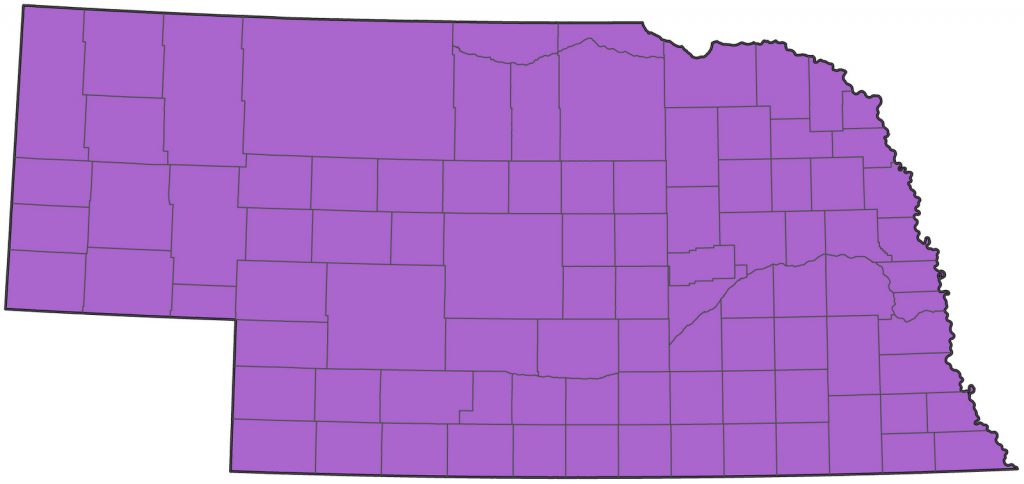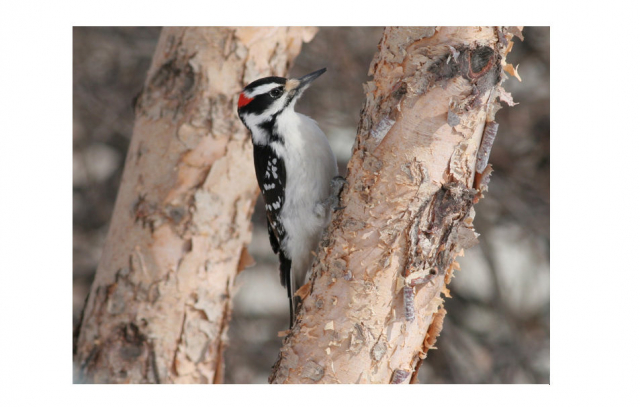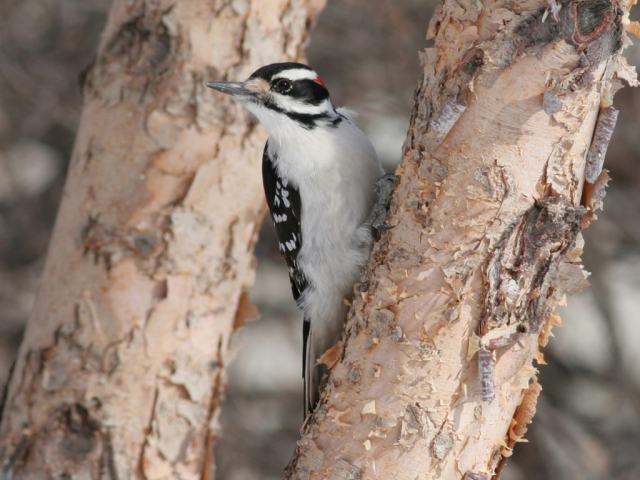Leuconotopicus villosus villosus, L. v. monticola
Status: Common regular resident west, fairly common central and east. Rare regular winter visitor west.

Documentation: Specimen: UNSM ZM6321, 12 Dec 1895 Fort Robinson, Sioux Co.
Taxonomy: Species previously included in Picoides (Fuchs and Pons 2015, Chesser et al 2018): Red-cockaded, Arizona, Hairy, and White-headed of the US, Smoky-brown of Mexico and South America), and Strickland’s (of central Mexico). are moved to genus Leuconotopicus.
Seventeen subspecies of Hairy Woodpecker are recognized, 11 of which occur north of Mexico (AviList 2025). Pyle’s (1997) Western Interior Group contained subspecies septentrionalus, breeding from Alaska across Canada to Quebec, monticola, breeding in the Rocky Mountains from central British Columbia and northern New Mexico east to southwestern South Dakota, wintering to northwestern Nebraska. Pyle’s (1997) Eastern Group consisted of terranovae of Newfoundland, villosus, breeding from North Dakota and northern Texas to Nova Scotia and Virginia, wintering to Texas and North Carolina, and audubonii, breeding south of villosus, from southern Illinois and eastern Texas to North Carolina and Florida.
Pyle (1997) included monticola in septentrionalis, but Jackson et al (2020) and AviList (2025) retained monticola separate from septentrionalus, which we follow here.
Nebraska breeding birds are presumed villosus; earlier authors suggested that monticola may be resident in northwest Nebraska as it is in the Black Hills of South Dakota (Bruner et al 1904, AOU 1957, Jackson et al 2020) (see below).
Although most Nebraska records of monticola are in fall and winter, summer records are increasing, albeit confined to the Panhandle. Of about 45 records in all, about 33 are from Sep-Jan, although since 2019 there have been about 11 records for Apr-early Sep on the Pine Ridge and at Wildcat Hills, suggestive of possible breeding (see below).
An interesting series of about 22 reports of monticola from a Mitchell, Scotts Bluff Co feeding station yard, presumably a non-breeding location, suggests occurrence of arrivals in winter from breeding locations in Wyoming and possibly Nebraska and/or South Dakota. In four winters, 2013-2014, 2014-2015, 2015-2016, and 2020-2021, birds were present beginning 6 Oct and ending 9 Feb. There were two Apr occurrences, 26 Apr-17 May 2014, and 8 Apr 2020. In addition, there are 14 records Sep-Mar from several Panhandle locations, supporting the concept of a winter influx. It occurs at Barr Lake, Colorado, late Aug-early May, where local breeding birds are eastern villosus (Andrews et al 2002).
The possibility of breeding by monticola is suggested by about 11 recent records from Apr-early Sep for several Panhandle locations, nine of these in Mar-Apr, suggest at least a spring influx and the possibility of breeding, at least at the Pine Ridge and Wildcat Hills. Such records for the Pine Ridge are at West Ash Creek, Dawes Co 6 May 2020, Box Butte Reservoir, Dawes Co 25 May 2021, Sowbelly Canyon, Sioux Co 26 May 2021, 31 May 2024, and 24 Aug 2019 (2), Fort Robinson SP, Dawes Co 1 Sep 2021, and Gilbert-Baker WMA, Sioux Co 1 Sep 2021. At the Wildcat Hills similar records are 10 Apr-30 Jul 2025, 16 Jun 2019, 23 Jun 2022, and 25 Aug 2020, the latter two at Carter Canyon. One was at Gering Cemetery, Scotts Bluff Co 22 Apr 2024.
Possible occurrence of septentrionalis in winter in Nebraska is discussed under Winter.
Hybridization with Downy Woodpecker is discussed at Hybrids – Birds of Nebraska – Online (outdoornebraska.gov).
Resident: The preferred habitat for this species is mature forest, and so in summer it is most numerous in the east but is distributed evenly over the rest of the state in lesser numbers. BBS data indicate that this species is far more common in the east than elsewhere. In winter and during migration periods it occurs statewide in virtually all arboreal habitats; at this season it is often found in cities and towns.
-
- Breeding Phenology
Nest-building: 6 Apr
Eggs: 20 May-16 Jul (Mollhoff 2022)
Nestlings: 10 May-21 Jun
Fledglings: 25 Jun-11 Jul - An egg date 16 Jul may have been a renesting attempt Mollhoff 2022).
- High counts: 12 at Fontenelle Forest, Sarpy Co 1 Apr 2017, 12 in Sowbelly Canyon, Sioux Co 19 Oct 2019, 11 at Harlan County Reservoir, Harlan Co 19 Mar 2010, and 11 at Fontenelle Forest 3 Apr 2010.
- Breeding Phenology
Winter: Although this species is usually considered to be resident, there is “evidence to indicate a general southward movement in fall; the individuals seen in winter are probably not the same as those seen in summer” (Bent 1939). Jackson et al (2020) state that there is no evidence that true migration occurs but cite several examples of influxes of northern subspecies including septentrionalus. Altitudinal movement of the Rocky Mountain (and Black Hills) birds, monticola, occurs in fall and spring, with these birds appearing on the Colorado plains in winter (Andrews and Righter 1992, Andrews et al 2002) and presumably also in western Nebraska. Interestingly, CBC data indicate even distribution of Hairy Woodpeckers in winter across the state, in contrast to the summer concentration in the east indicated by BBS data, suggesting an influx into western Nebraska in at least early winter. Rosche (1982) stated that Hairy Woodpecker is more numerous in winter in the northwest, but that no winter influx was noted further east in the Keith Co area (Rosche 1994).
Images
Abbreviations
BBS: Breeding Bird Survey
CBC: Christmas Bird Count
NC: Nature Center
UNSM: University of Nebraska State Museum
Literature Cited
Andrews, R., and R. Righter. 1992. Colorado birds. Denver Museum of Natural History, Denver, Colorado, USA.
Andrews, R., R. Righter, M. Carter, T. Leukering, and A. Banks. 2002. Birds of Barr Lake and Surrounding Areas 1888 through 1999. An Annotated Checklist. Rocky Mountain Bird Observatory Ornithological Monograph.
American Ornithologists’ Union [AOU]. 1957. The AOU Check-list of North American birds, 5th ed. Port City Press, Baltimore, Maryland, USA.
AviList Core Team, 2025. AviList: The Global Avian Checklist, v2025. https://doi.org/10.2173/avilist.v2025.
Bent, A.C. 1939. Life histories of North American woodpeckers. Bulletin of the United States National Museum 174. Dover Publications Reprint 1964, New York, New York, USA.
Bruner, L., R.H. Wolcott, and M.H. Swenk. 1904. A preliminary review of the birds of Nebraska, with synopses. Klopp and Bartlett, Omaha, Nebraska, USA.
Chesser, R.T., K.J. Burns, C. Cicero, J.L. Dunn, A.W. Kratter, I.J. Lovette, P.C. Rasmussen, J. V. Remsen, Jr., D.F. Stotz, B.M. Winger, and K. Winker. 2018. Fifty-ninth Supplement to the American Ornithological Society’s Check-list of North American Birds. Auk 135: 798-813.
Fuchs, J., and J-M. Pons. 2015. A new classification of the Pied Woodpeckers assemblage (Dendropicini, Picidae) based on a comprehensive multi-locus phylogeny. Molecular Phylogenetics and Evolution 88: 28-37. https://doi.org/10.1016/j.ympev.2015.03.016.
Jackson, J.A., H.R. Ouellet, and B.J. Jackson. 2020. Hairy Woodpecker (Dryobates villosus), version 1.0. In Birds of the World (P. G. Rodewald, Editor). Cornell Lab of Ornithology, Ithaca, NY, USA. https://doi.org/10.2173/bow.haiwoo.01.
Mollhoff, W.J. 2022. Nest records of Nebraska birds. Nebraska Ornithologists’ Union Occasional Paper Number 9.
Pyle, P. 1997. Identification Guide to North American Birds. Part I, Columbidae to Ploceidae. Slate Creek Press, Bolinas, California, USA.
Rosche, R.C. 1982. Birds of northwestern Nebraska and southwestern South Dakota, an annotated checklist. Cottonwood Press, Crawford, Nebraska, USA.
Rosche, R.C. 1994. Birds of the Lake McConaughy area and the North Platte River valley, Nebraska. Published by the author, Chadron, Nebraska, USA.
Recommended Citation
Silcock, W.R., and J.G. Jorgensen. 2025. Hairy Woodpecker (Leuconotopicus villosus ). In Birds of Nebraska — Online. www.BirdsofNebraska.org
Birds of Nebraska – Online
Updated 8 Sep 2025


